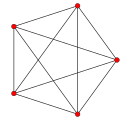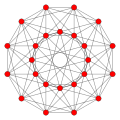600-cell
| 600-cell | |
|---|---|
 Schlegel diagram, vertex-centered (vertices and edges) | |
| Type | Convex regular 4-polytope |
| Schläfli symbol | {3,3,5} |
| Coxeter diagram | |
| Cells | 600 (3.3.3) |
| Faces | 1200 {3} |
| Edges | 720 |
| Vertices | 120 |
| Vertex figure |  icosahedron |
| Petrie polygon | 30-gon |
| Coxeter group | H4, [3,3,5], order 14400 |
| Dual | 120-cell |
| Properties | convex, isogonal, isotoxal, isohedral |
| Uniform index | 35 |
In geometry, the 600-cell is the convex regular 4-polytope (four-dimensional analogue of a Platonic solid) with Schläfli symbol {3,3,5}. It is also known as the C600, hexacosichoron[1] and hexacosihedroid.[2] It is also called a tetraplex (abbreviated from "tetrahedral complex") and a polytetrahedron, being bounded by tetrahedral cells.
The 600-cell's boundary is composed of 600 tetrahedral cells with 20 meeting at each vertex.[a] Together they form 1200 triangular faces, 720 edges, and 120 vertices. It is the 4-dimensional analogue of the icosahedron, since it has five tetrahedra meeting at every edge, just as the icosahedron has five triangles meeting at every vertex. Its dual polytope is the 120-cell.
Geometry[]
The 600-cell is the fifth in the sequence of 6 convex regular 4-polytopes (in order of size and complexity).[b] It can be deconstructed into twenty-five overlapping instances of its immediate predecessor the 24-cell,[4] as the 24-cell can be deconstructed into three overlapping instances of its predecessor the tesseract (8-cell), and the 8-cell can be deconstructed into two overlapping instances of its predecessor the 16-cell.[5]
The reverse procedure to construct each of these from an instance of its predecessor preserves the radius of the predecessor, but generally produces a successor with a smaller edge length.[c] The 24-cell's edge length equals its radius, but the 600-cell's edge length is ~0.618 times its radius. The 600-cell's radius and edge length are in the golden ratio.
| Regular convex 4-polytopes | |||||||
|---|---|---|---|---|---|---|---|
| Symmetry group | A4 | B4 | F4 | H4 | |||
| Name | 5-cell Hyper- |
16-cell Hyper- |
8-cell Hyper- |
24-cell | 600-cell Hyper- |
120-cell Hyper- | |
| Schläfli symbol | {3, 3, 3} | {3, 3, 4} | {4, 3, 3} | {3, 4, 3} | {3, 3, 5} | {5, 3, 3} | |
| Coxeter diagram | |||||||
| Graph | 
|

|

|

|

|

| |
| Vertices | 5 | 8 | 16 | 24 | 120 | 600 | |
| Edges | 10 | 24 | 32 | 96 | 720 | 1200 | |
| Faces | 10 triangles | 32 triangles | 24 squares | 96 triangles | 1200 triangles | 720 pentagons | |
| Cells | 5 tetrahedra | 16 tetrahedra | 8 cubes | 24 octahedra | 600 tetrahedra | 120 dodecahedra | |
| Tori | 1 5-tetrahedron | 2 8-tetrahedron | 2 4-cube | 4 6-octahedron | 20 30-tetrahedron | 12 10-dodecahedron | |
| Inscribed | 120 in 120-cell | 1 16-cell | 2 16-cells | 3 8-cells | 5 24-cells x 5 | 5 600-cells x 2 | |
| Great polygons | 2 | ||||||
